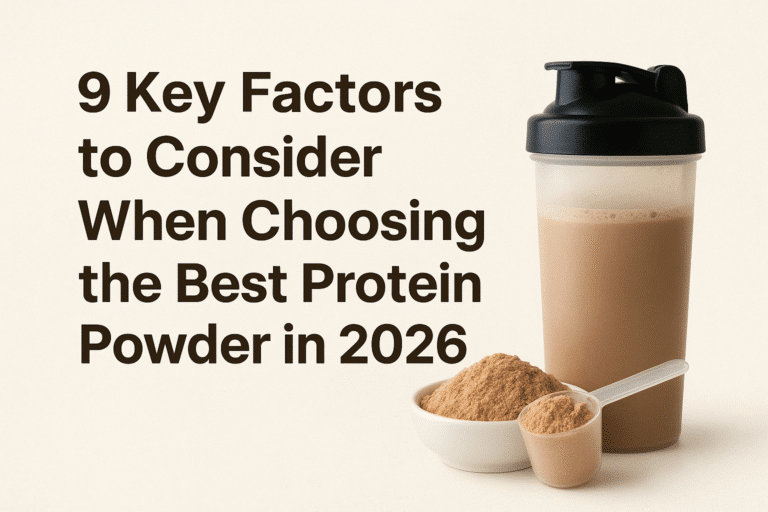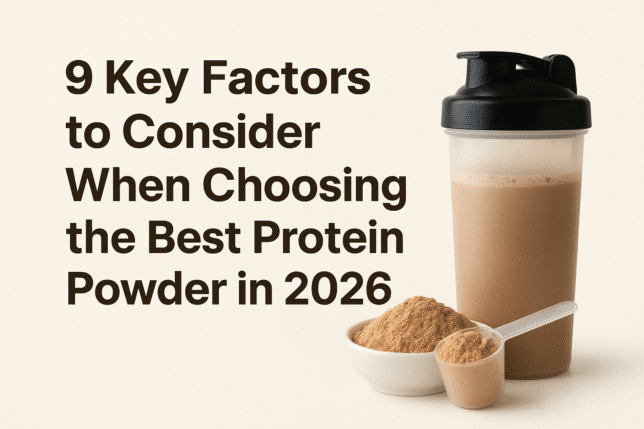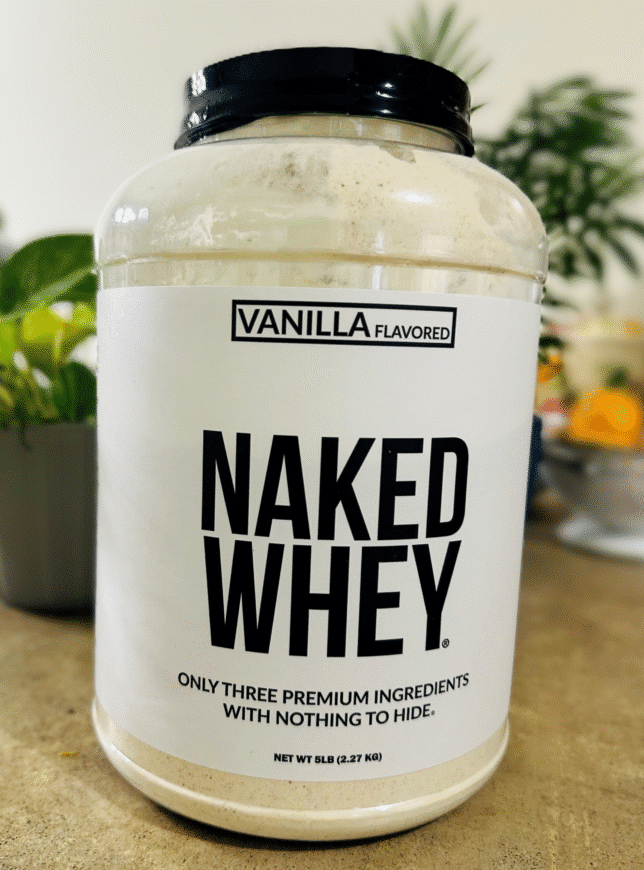Protein powder isn’t just for bodybuilders anymore. In 2026, it’s become a daily tool for fitness enthusiasts, busy professionals, parents, and anyone looking to support recovery, muscle growth, or overall nutrition. But with so many options — whey, plant-based, blends, isolates, cold-processed, fermented, enzyme-enhanced — it can be overwhelming to know which one actually works.
Popular options like Naked Whey, Optimum Nutrition Gold Standard 100% Whey, Orgain Organic Plant-Based Protein, Garden of Life Raw Protein, and Dymatize ISO100 showcase the wide variety available — from whey isolate to plant blends, cold-processed whey, fermented plant protein, enzyme-enhanced formulas, and more. But with hundreds of brands on the market, choosing the best protein powder can feel overwhelming.
So, what should you really look for when choosing the best protein powder?
To answer this, we reached out to nine experts — from gym coaches to medical professionals and nutrition entrepreneurs — to share what matters most in 2026. Their insights go far beyond marketing hype, helping you pick a protein powder that supports both your body and your lifestyle.
Quick Summary: Best Protein Powder in 2026
Before diving into the expert advice, here’s a snapshot of the key factors they all emphasized:
- Protein-to-calorie ratio – efficient protein, minimal fillers
- Digestibility & enzymes – for gut comfort and recovery
- Third-party testing – batch-specific results for safety
- Artificial sweeteners & additives – too much can affect sleep and digestion
- Heavy metal testing – especially important for plant proteins
- Amino acid profile & leucine threshold – essential for muscle growth
- Mixability & texture – impacts daily adherence
- Processing quality – cold processing and mesh size matter
- Simplicity & transparency – few ingredients, no proprietary blends
Explore The Expert Insight: Best Protein Powder in 2026
1. Protein Ratio and Digestive Enzymes Drive Recovery

Robby Welch, National Head Coach at Legends Boxing, highlights the importance of protein efficiency and gut-friendly formulas:
“Great question. As National Head Coach at Legends Boxing and someone who’s competed myself while coaching thousands through fitness changes, I’ve seen the real-world difference protein timing and quality makes in recovery and results.
Here’s what I actually tell our coaches and members: look at the protein-to-calorie ratio first. I recommend 0.8 to 1 gram of protein per pound of body weight daily, and hitting at least 30 grams post-workout for muscle recovery. Your powder should deliver 20-25g protein per 100-120 calories max–anything less means you’re drinking filler. When we implemented this guideline at Legends, members stopped complaining about feeling bloated or not seeing strength gains despite consistent training.
The one factor nobody mentions enough is digestive enzyme blends. I learned this the hard way when bulking for my amateur fight–eating massive amounts of protein without proper digestion just left me feeling awful between training sessions. Powders with added protease, lactase, or bromelain break down protein faster, which matters when you’re doing high-intensity boxing rounds and need quick recovery. Our member coaches noticed clients who switched to enzyme-improved powders stopped skipping evening classes due to stomach issues.
Skip anything with proprietary blends that hide exact ingredient amounts. If a brand won’t tell you precisely what’s inside, they’re banking on you not caring. I’ve analyzed performance metrics across our gyms nationwide–the members making consistent strength and endurance gains are the ones treating supplements like they treat their training: with specifics, not guesses.”
Takeaway: Look for a protein powder with a high protein-to-calorie ratio and added enzymes if you want faster digestion and better recovery. Avoid products that hide their ingredients in proprietary blends.
2. Subscription Flexibility and Batch Testing Build Trust

Cheryl Cassaly, Chief Marketing Officer at Rehab Essentials, brings an overlooked but crucial perspective: convenience and transparency.
“I spent 20+ years building education programs that serve working professionals across time zones–from Montana to Manila. The lesson that translates to protein powder: prioritize what fits your actual routine over what tests best in a lab. I’ve watched hundreds of clinicians abandon ‘optimal’ solutions because they didn’t mesh with real life–same applies to supplements.
Here’s what nobody mentions: check if the brand offers cohort or subscription pricing with flexible pause options. Protein companies like Transparent Labs and MyProtein now do this–you’re not locked into 3-month auto-ship when your training intensity drops. Calculate cost per serving only for containers you’ll actually finish before they expire.
The second factor from building scalable programs: look for brands that publish batch testing results with actual lot numbers you can cross-reference. If a protein company won’t show you third-party testing for your specific container’s batch, they’re asking you to trust marketing over evidence.”
Takeaway: Choose brands that let you pause subscriptions or buy in smaller, flexible amounts. Always verify batch-specific third-party testing for safety and potency.
3. Artificial Sweeteners and Heavy Metals Threaten Health

Jason Setsuda, CFO at Memory Lane, explains why sweetness and soil contamination matter:
“I run multiple healthcare businesses including hospice and aesthetics work, and here’s what I never see people mention: look at the artificial sweetener load and how it affects your sleep architecture. In the ER, I’ve had patients come in with heart palpitations and anxiety, and when we dig into their history, they’re consuming 3-4 scoops of heavily sweetened protein powder daily.
The second thing from my medical director perspective: check if the company does third-party heavy metal testing specifically for cadmium and lead. Plant-based proteins pull these from soil, and I’ve seen lab work on patients with unexplained fatigue show liftd cadmium levels correlating with their daily vegan protein shake habit.
Price-wise, I tell my aesthetic patients to calculate cost-per-20g of actual protein, not per serving. A $60 tub with 15g protein per scoop costs more than an $80 tub with 28g when you do the math. Most people overpay by 40% because they look at container price instead of protein density.”
Takeaway: Check for heavy metals and sweetener content. A higher-priced, cleaner protein may give better results than a cheaper, overly sweetened alternative.
4. Leucine Trigger and Third-Party Testing Matter Most

Murray Seaton, Founder and CEO of Hypervibe, emphasizes the science of amino acids:
“Choosing the right protein powder in 2026 boils down to one rule: opt for signal, not hype. Ignore the shiny tubs—flip it around and look for what actually matters.
First, hit the leucine trigger. You want 2.5 g leucine per serving—that’s the switch for muscle growth. If they don’t show the Amino profile? Move on. A protein-by-weight ratio of 75%+ (e.g., 25 g protein in a 33 g scoop) is your second quick scan—it filters out fillers and label fluff.
Second, check the CoA. A real one. QR code on the label linking to third-party testing for heavy metals, protein accuracy, and contaminants. If they’re not transparent with that, don’t trust what’s inside.
Third, digestibility. Whey isolate (especially microfiltered) is gold for most—low lactose, fast absorbing, and gentle on the gut. For plant options, look for fermented or enzyme-treated blends to bump up bioavailability and reduce GI drama. Skip products with carrageenan, sugar alcohols, or hidden gums—your gut will thank you.”
Takeaway: Amino acid content matters more than scoop size. Always check leucine content and third-party certificates.
5. Mixability and Workout Timing Affect Performance Daily

Jennifer Rapchak, Fitness Director at Results Fitness Gym, highlights the everyday user experience:
“I’ve been programming workouts and coaching members for over 14 years, and here’s what I rarely see discussed: mixability and texture under real-world conditions. When you’re blending protein at 5 AM in a shaker bottle with just water, clumping matters. Test a single-serve packet before committing to a 5-pound tub—your consistency depends on whether you can actually get it down every day.
The second factor from my training floor perspective: how it affects your actual workout performance within 60-90 minutes. Some isolates digest so fast they leave you hungry mid-session, while certain blends with added fats sit heavy during HIIT or CXWORX classes. Match your protein type to your training window–fast-digesting isolates pre-workout, slower blends post-workout or as meal replacements.”
Takeaway: Even the best protein won’t help if you can’t tolerate the texture or timing. Always test for mixability and digestibility in real-world conditions.
6. Personal Digestion and Amino Acid Completeness Count

Joy Grout, Owner of Personalized Fitness For You, reminds us that nutrition is personal:
“I’ve trained clients for over 20 years, and the most overlooked factor is how well the protein actually digests in your body specifically. I had a client in her late 50s who was taking a popular whey isolate and felt sluggish every time–we switched her to a blend with added digestive enzymes, and suddenly she had energy for her afternoon walks. Your gut changes as you age, so what worked at 30 might wreck you at 50.
The amino acid timing on the label tells you if it’s actually complete. I always check if all nine essential amino acids are listed with amounts, not just ‘proprietary blend.’ For plant-based options, I specifically look for pea-rice combinations because solo pea protein is missing methionine. If you see ‘sprouted’ on plant proteins, that’s even better–sprouting increases bioavailability by 20-30% in some studies I’ve read.”
Takeaway: Listen to your body. Your digestion, age, and dietary preferences will influence which protein works best.
7. Cold Processing and Mesh Size Impact Quality

Adam Bocik, Partner at Evergreen Results, explains why production methods matter:
“The processing temperature matters more than anyone talks about. Cold-processed whey (under 72degF) keeps the protein structure intact, which directly affects how your body uses it. One thing nobody checks: the mesh size on the powder. 80-mesh powders mix clean in 10 seconds while 40-mesh creates clumps and tastes chalky. Ask the brand directly what mesh they use—if they don’t know, that tells you everything about their quality standards.”
Takeaway: Cold processing preserves protein quality, and mesh size affects texture. Both influence taste, digestion, and long-term adherence.
8. Amino Acid Spiking and Sodium Sabotage Results

Len Berkowitz, Co-Founder at Center For Men’s Health of Rhode Island, warns about hidden pitfalls:
“The one factor nobody checks that I see sabotage results: amino acid spiking. Manufacturers add cheap aminos like glycine or taurine to inflate the protein number on the label, but your muscles can’t use them the same way. …The other thing is sodium content per serving. Some protein powders dump 300-400mg sodium per scoop–that’s 15-20% of your daily limit from one shake.”
Takeaway: Look for accurate amino acid profiles and moderate sodium content, especially if you have blood pressure or cardiovascular concerns.
9. Five Clean Ingredients and Third-Party Testing Win

Livia Esterhazy, Owner of The Thrive Collective, simplifies it all:
“In 2026, I’d tell people to look for simplicity and integrity on the label — five clean ingredients or fewer, no fillers, gums or sweeteners you can’t pronounce. Choose a protein source that works for your body (whey if you tolerate dairy, or pea/rice blends if you don’t) and make sure it’s third-party tested for heavy metals or contaminants. I always say: if your grandmother wouldn’t recognize the ingredients, it’s probably not helping you thrive.”
Takeaway: Simple, clean, and transparent is always better than fancy marketing claims.
Comparison Table: 2026 Best Protein Powder Overview
| Protein Type | Pros | Cons | Best For | Expert Tip |
|---|---|---|---|---|
| Whey Isolate | Fast digestion, high leucine | Can digest too fast pre-workout | Strength, muscle gain | Cold-processed, microfiltered |
| Whey Concentrate | Natural fats, smoother | Slightly lower protein ratio | Beginners, general fitness | Grass-fed, low-temperature processed |
| Plant Blends | Complete amino acids | Possible heavy metals | Vegans, sensitive stomachs | Pea + rice or sprouted/fermented |
| Egg White | Highly digestible | Lower protein density | Seniors, low-carb | Minimal additives, clean ingredients |
| Fermented Plant | Easy digestion | More expensive | Sensitive digestion | Fermented/sprouted formulas |
Key Themes: What All 9 Experts Agree On
After analyzing the expert insights, a few clear themes emerge. These themes can guide any consumer picking the best protein powder in 2026.
1. Transparency Is Non-Negotiable
Experts repeatedly warned against:
- Proprietary blends
- Hidden ingredients
- Missing amino acid profiles
- Sweeteners disguised as “natural”
Brands that publish batch-specific test results stand out.
2. Digestibility Drives Results (and Consistency)
Across coaches and medical leaders, digestion was cited as the #1 issue affecting:
- Bloating
- Gym performance
- Recovery quality
- Long-term adherence
Digestive enzymes, cold processing, and low gum/sugar alcohol content were major standouts.
3. Amino Acid Quality Beats Total Protein
Leucine threshold (2.5g) and complete amino profiles matter more than:
- Marketing
- Scoop size
- Total protein number
Plant proteins require careful formulation (pea + rice, fermented, sprouted).
4. Contaminant Testing Matters — Especially Heavy Metals
Nearly half the experts highlighted:
- Cadmium
- Lead
- Sodium
- Cheap amino fillers
2026 consumer expectations have moved toward purity and trust.
5. Mixability and Taste Influence Daily Compliance
Even the best protein powder fails if you don’t want to drink it.
Mesh size, emulsifier use, and processing quality directly determine:
- Smoothness
- Clumping
- Digestive feel
FAQs: Best Protein Powder in 2026
Q1: What’s the ideal protein-to-calorie ratio?
20–25g protein per 100–120 calories, according to multiple experts.
Q2: Are artificial sweeteners safe?
High amounts can disrupt sleep, cortisol, and digestion. Moderation and label-reading are key.
Q3: How do I know if a powder is clean?
Check batch-specific third-party testing via NSF, Labdoor, or QR-linked Certificates of Analysis.
Q4: Does processing temperature matter?
Yes. Cold processing preserves protein structure and enhances digestion.
Q5: Should I worry about heavy metals?
Especially with plant proteins, ask for cadmium and lead testing.
Q6: How much leucine per serving?
Aim for 2.5g for optimal muscle protein synthesis.
Conclusion
Choosing the best protein powder in 2026 isn’t about the flashiest packaging or the highest scoops-per-tub. It comes down to purity, digestibility, transparency, and daily usability. The experts make one thing clear: what’s on the front label matters far less than what’s hiding in the ingredients, amino profile, and testing documentation.
Whether your goal is muscle gain, fat loss, improved recovery, or simply a cleaner supplement routine, applying these nine expert-backed principles will ensure you’re choosing a protein powder that genuinely supports your health, performance, and long-term well-being.
If the powder is clean, tested, digestible, transparent, and enjoyable to drink — it’s the right one for you.
Ankita holds a Ph.D. in Biotechnology and contributes to Stunning Motivation as a Writer and Editor, where she explores the intersection of science, psychology, and personal growth. Her articles focus on mindfulness, motivation, mental health, and productivity, helping readers apply evidence-based insights to live with clarity and purpose. She is currently finishing two books — one on Biotechnology and another on the Goal Setting Formula.

















